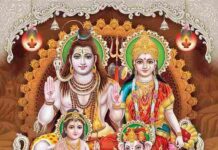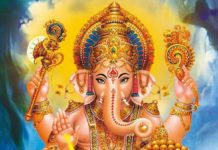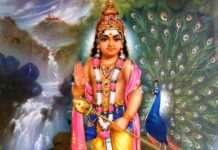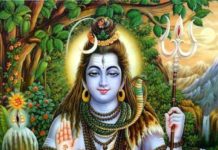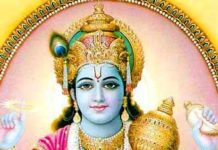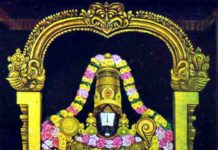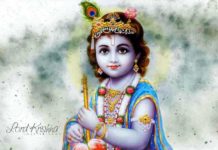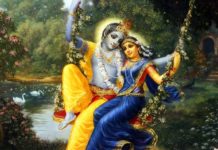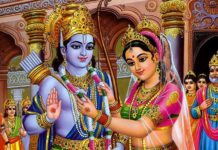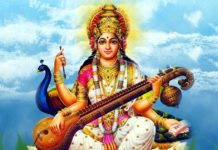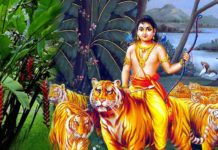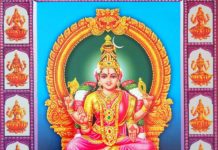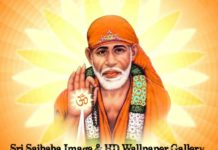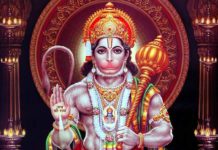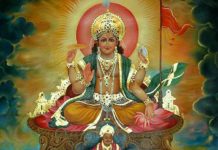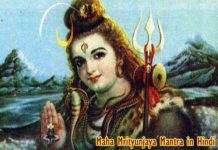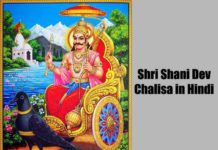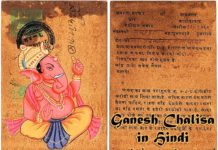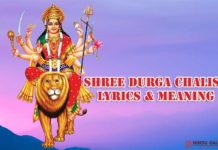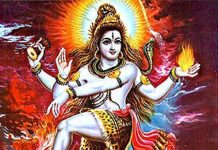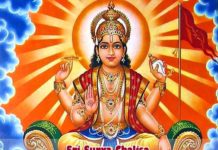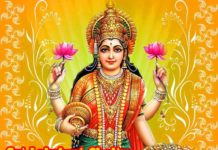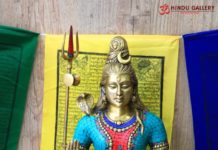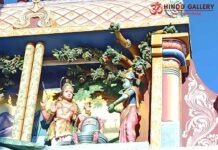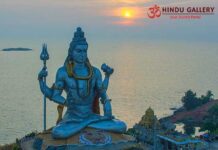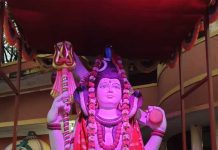Thiruvallur is the town near Chennai in which one of the 108 Divya Desam temples ascribed to Bhagwan Maha Vishnu exists. The temple is called Sri Vaidhya Veera Raghava Swami Devasthanam.
It is believed that this temple was constructed in 8th Century C.E by Pallava Kings and later developed by Vijaya Nagara Kings.

Thiruvallur was earlier known as Thiru Evvalur. In Puranic times, this place was called as Kingirukesha puri and Veeksharanyam. Veeksharnaya kshetram is said to be hailed in eleven chapters of Sri Markhandeya Puranam. The place is referred as Punyavartha Kshetram.

There is a legend with respect to Salihothra Maharishi. At Badhrika Ashram, there was a sage named Puru Punya and his wife Sathee. They did not have progeny. The Sage did penance and homam on Sri Maha Vishnu seeking His blessings. Pleased with his devotion, Bhagwan had appeared before him through the homa agni. The sage asked for progeny. Bhagwan had blessed that he would beget a son who would be a great sage.
As blessed by Bhagwan, the sage and his wife were blessed with a boy. They brought up the child as the spiritual scholar teaching him all the vedas and scriptures. The boy matured into a spiritual devout and pious man. After sometime, he started travelling for theertha yathra.
He reached Veekharanyam. There on Thai Amavasya day, he saw the Devas, Rishis and humans taking holy dip in the Hrutha Paapa Naashini tank. He had surmised that the place was idea for doing penance. He did penance for a year foregoing food.
On the next Thai Amavasya day, he had again seen the Rishis and Devas at the tank. He had decided to end his penance. He had collected the rice grains from the ground, made them into eatable rice flour and made it into four portions. He kept one portion for any Athithi (guest) and decided to have his meal after giving food to Athithi.
An old man came to the sage asking for food. He gave him the Athithi portion. But the guest still had hunger. The Sage had given him the portion kept for himself. After eating that, the guest was satisfied and left.
The sage had again gone into penance and did so for one more year. On the next Thai Amavasya, again he had made food with the grains collected from the ground and waited for the Athithi. This time too, the old man came and did what he had done last year. He had taken all the food. Further, he also wanted to take rest.
He asked the sage EvvuL? (where to rest). The sage showed him his parna shaala. In Tamil, EvvuL means which place. The Sage also offered him a blanket named Pappulli Dhuppatti.
The Athithi went into the parna shaala, put His head on the southern side, covered Himself with the blanket and reclined. At that time, there was sounding of Deva loka instruments and in the place of the Athithi, Sriman Narayana had given darshan.
Bhagwan had told the sage that He was pleased with the penance and patience of the sage and that He would grant him any wish. The sage had asked for the opportunity to serve Bhagwan forever. Bhagwan had blessed that the sage would henceforth be called as Saalihothra Maharishi and the place would be hailed as Thiru EvvuL oor.

The name then became Thiruvallur. In Sanskrit, the name is Kim Gruha Puram.
On entering the temple, we sight the Dwaja Sthambam.

To the left of the Dwaja Sthambam, we can reach the main sanctum which is on the elevated mandapam. The mandapam has sculptured pillars. There are Dwara Palakas on the either side of the door of the main sanctum.

Once we reach the main sanctum, we get the darshan of Sri Vaidhya Veera Raghava Perumal in the reclining pose on bhujangam (snake).
At the main sanctum, Sri Maha Vishnu depicts the core of two of His sahasra namas (thousand names). The names are Beshajam and Bishak. In simple terms, Beshajam refers to medicine and Bishak refers to physician. His head is in the south side and His feet are at north side. With one hand, He teaches Pranav manthra to Sri Brahma and with the other hand, He blesses the head of Sri Salihothra Maharishi.

After having the darshan of Sri Veera Raghava Swamy, we perambulate the main sanctum. In the perambulation, we get the darshan of Sri Narasimha Swamy.
After completing the perambulation, we come out of the main sanctum mandapam to reach the Sannidhi of Sri Kanaka Valli Thayar.

Sri Maha Lakshmi is worshipped as Sri Kanaka Valli Thayar. As per the legend, Sri Lakshmi was born as Vasumathi, the princess of Dharma sena puram. Her parents were King Dharmasena Maharaja and Queen Gauthami. Sri Veera Raghava Perumal had appeared in person as an youngster before Vasumathi and proposed to Her.
With the consent of the royal couple, Sri Veera Raghava and Sri Vasumathi got married on Thai-Pooratathi day. The married couple entered into the main sanctum of the temple and disappeared. The King realized that Sri Vishnu was his Son-in-Law and Sri Lakshmi was his daughter.
Coming out of Sri Thayar Sannidhi, we get to have the darshan of Sri Ramachandra Murthy, Sri Seetha Devi, Sri Lakshman and Sri Hanuman in a separate sanctum. After that, we worship Bhagwan Sri Krishna in a separate sanctum. There is an elevated mandapam having the sanctum of Sri Vedantha Desikan. Then we get the darshan of Sri Andal in another sanctum.
There is a Thula Bharam (weighing scale) for the devotees to make their offerings. Opposite Andal Sannidhi, in the parikrama route of the temple, we can see a small mandapam which is called as Velli Kilamai Mandapam.

At this Mandapam, the Urchava Murthy is kept for darshan and puja every Friday.
Then towards our left, we see an enclosure named “Theertha Kinaru” which had the temple well.

Further down the parikrama path, to our right, we see another small mandapam. At this mandapam, the devotees whose ailment has cured pour rock salt and pepper as token of gratitude.

After offering the salt and pepper, the devotees do pradikshana of the mandapam three times.
Further down the path, to the left, we can see the Sannidhi for Sri Bhashyakara. Then there is a large mandapam for conducting various festivals.
Besides these, there are small sanctums for Alwars, Sri Anjaneya and Sri Ramanuja inside the temple.
The vimanam of the main sanctum is called as Sri Vijaya Koti. As per the legend, the place was called as Veeksharanyam where people were living quite peacefully and happily. At that time, two auras named Madhu and Kaidaba were creating havoc to all. None of the Deities could fulfill their duties and there was chaos everywhere. As requested by Sages and Devas, Sri Maha Vishnu had sent His Sudarshan chakra to diminish the demons. Not able to withstand the ferocity of the chakra, the demons had come to Veeksharanyam to escape. There Sri Bhagwan took vishvaroop and diminished them.

He had taken rest on the Adi Sesha at that place to celebrate the victory over the demons. Hence the vimanam is called as Sri Vijaya Koti Vimanam. The specialty of the Kshetram is that whatever good deed done there multiplies and all sins get diminished. That is why even the demons attained salvation.
It is sincerely believed that having the darshan of the main sanctum vimanam after Swami darshan would result in alleviation of all kinds of ailments.
There is a separate Anjaneya Swami temple opposite the main temple.

Sri Maha Vishnu had given darshan in reclining pose to Sri Salihothra Maharishi who was doing penance at the banks of Hruth thaaba naashini. The name of the temple tank means the fulfiller of the heart’s wishes.

As per legend, King Prathyumna had done penance on Sri Maha Vishnu in the banks of this pond seeking the blessing of progeny. Bhagwan Vishnu gave darshan to the King on Thai Amavasya day. He prayed for progeny and also asked for abundant blessings to the devotees who worship Sri Vishnu at the temple pond on Thai Amavasya day. Hence it is believed that on Thai Amavasya, all the holy river waters come to this temple tank.
As per the legend, when King Daksha had done Yagna without inviting his Daughter Sathi and Son-in-Law Maheshwar, Sathi felt insulted and immolated Herself in the Yagna fire. Bhagwan Shiv had sent His manifestation called Rudra to diminish Daksha. Rudra did as ordained. However, He was afflicted with Brahma-hathya dosh. He came to Veeksharanyam and took dip in Hruth Thapa Naashini pond and His dosh was alleviated. He has a temple named Theertheeswarar near the tank.
It is also called as Hruth Paapa Naashini as it alleviates the sins which are even thought in the mind. Seeing the pond, feeling the water and taking dip in it give same effects. It is believed that it alleviates the ill effects of sins of previous births. Earlier, devotees used to dilute jaggeries in the temple tank water once their ailments are cured and their wishes fulfilled. Nowadays, jaggery diluting is not allowed.

The temple and Sri Veera Raghava Perumal are eulogized the sages and scholars in their scripts. Sri Thirumazhisai Alwar, Sri Thiru Mangai Mannan, Sri Thuppul Vedantha Desikacharya and Sri Ramalinga Adigal had composed hymns and slokams on the Deity.
Rituals
The daily pujas are done as per pancha rathra agamas. Kalasanthi Puja is done at 08.00 A.M, followed by Uchi Kala Puja at 12.00 Noon, Saya Ratcha Puja at 06.00 P.M and Ardha Jama Puja at 08.30P.M. The regular rituals are Alankaram, Neivedhyam, Deepa Aradhana and Vedic chanting. The Puja times may differ during festivals.
Festivals
In Chaithra month (April-May), Theertha vaari and nine days Brahmothsavam culminate on Chithra Star-day. Ten days Thiruvadirai Udayavar chaatru murai festival is also celebrated.
In Vaikasi month (May-June), Kodai Urchavam is held for three days starting from Kruthika Star-day. From Chithra Star-day, five days Theertha vaari and Vasanthothsavam is held. On Visakam Star-day, Nammalvar chaatru murai festival is also celebrated.
In Ani month (June-July), three days Theppotsavam (tank float festival) from Amavasya. On Chithra Star-day, Jyeshtabhikshekam is done to Sri Perumal. On the next Friday, Jyeshtabhishekam is done to Sri Thayar. On Swathi Star-day, Periyazhwar Nakshathram and Garuda Urchavam are celebrated.
In Adi month (July-August), Garuda Urchavam is held on Pournami day. On Puram Star-day, ten days Alwar Kalyana Urchavam is celebrated.
In Avani month (August-September), seven days Pavithra Urchavam is held from Pournami day. Uriyadi Urchavam is held on Sri Krishna Jayanthi day.
In Purattasi month (September – October), Navarathri festival is celebrated in a grand manner. Sri Thuppul Vedantha Desikan Urchavam is celebrated for ten days. Sri Adhi Van Sadagopa Yatheenthra Maha Desikan Urchavam is very prominent.
In Aippasi month (October – November), Thula month first day, Deepavali, Pooradam Star-day Senai Mudaliar chattrumurai are grandly celebrated.
In Karthikai month (November-December), on Kruthika Star-day, Thiru Mangai Manna Chattrumurai is celebrated. Karthigai Deepam festival is celebrated.
In Margazhi month (December-January), Pagal Pathu Urchavam is held ten days prior to Sri Vaikunta Ekadashi and Raa Pathu Urchavam is held for ten days after that. Bhogi Kalyana Urchavam is also held.
In Thai month (January – February), Sankaranthi is celebrated with Pari Vettai Urchavam. Ten days Brahmothsavam culminates on Purattadhi Star-day. Ratha Sapthami is celebrated grandly.
In Masi month (February-March), three days Theppotsavam is held from Amavasya day. On Mruga Sheersham Star-day, Thirukkachi Nambigal Chattrumurai Urchavam is held.
In Panguni month (March-April), on Sravana Star-day, five days Pallavotsavam culminates. From Punarvasu star-day, three days Dhavana Urthsavam is held. From Makha Star-day, three days Thayar Panguni Uththira Urchavam and Gandha Podi Vasantha Urchavam are celebrated.
Apart from the above, special pujas are done on all Ekadashi and Amavasya days.
The temple is maintained by Sri Ahobila Mutt.
Thiruvallur is easily reachable from Chennai either by buses or suburban trains. Taxis can also be booked.





